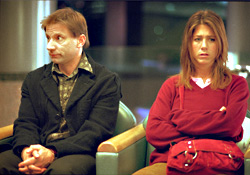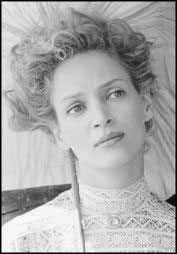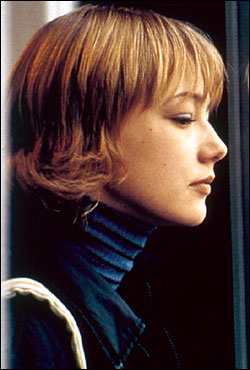Four close friends form the cornerstone of the brilliantly observed Friends With Money, three who have it, one who doesn’t. Even by L.A.’s pricey Westside standards, the characters played by Frances McDormand, Joan Cusack, and Catherine Keener (and husbands) stand out; in contrast, Jennifer Aniston isn’t just broke, “she’s unmarried, she’s a pothead, and she’s a maid.” True enough—and that’s from a friend. Actually Aniston’s character is in full flight, and if she wants to clean the hair out of people’s showers, who can blame her? She’s just quit teaching at a private Santa Monica grade school after the kids pitched quarters at her ancient Honda—with her in it. Still, abuse from 8-year-olds is nothing compared to what she puts up with from men, from the mildly gormless loser (beefy Bob Stephenson) who tries to chisel down her housecleaning rate to Cusack’s personal trainer (Scott Caan), Mr. Worst Date in Life, one jaw-dropping package of entitlement.
On the black side of the ledger, money turns out to be a lousy insulator against pain. Successful dress designer McDormand is in a full-scale midlife crisis, despite a loving, encouraging husband (Simon McBurney), who wouldn’t mind if they had a second child. Raging (hilariously, laceratingly) in public, privately she’s so shut down she won’t even wash her hair—or consider the fact that her husband seems to be catnip to every gay man in sight. (Bad enough that she has to monitor her son‘s play dates.)
Catherine Keener and Jason Isaacs are screenwriters adding an ocean-view upstairs family room—an expensive way of avoiding the fact that, by the time it’s built, their marriage may have run its course. Their sniping puts an increasing edge on every dinner the gang has together and turns their annual Christmas Tree Fight into a real donnybrook.
On the calmer, ever duller side are the really rich Joan Cusack and Greg Germann, whose sex life thrives and whose worst fights are over smoking (she still lets him) and whether their 3-year-old really needs $85 shoes (he’s for it.) He’s the sort of guy who can ask Aniston at dinner if she goes through her clients’ drawers. (Well, yes, she does, but who asks?)
As Money crackles into life, all I could think was how this ensemble of actresses must have felt driving to work every morning—like jaguars, getting tossed red meat. Keener’s accustomed to these riches. She’s been Holofcener’s painfully insecure alter ego from Walking and Talking (’96) to Lovely and Amazing (’01). Happy to report she’s glorious as ever, a shade less needy, but still likely to crack her shin on any solid object. Aniston, new to such gold-standard company, is the real surprise, doing far more than just keeping up. McDormand’s firestorm of a performance is the movie’s most over-the-line, did- she-really-say-that experience. Her pan-successful life is supposed to have left her in an existential, “Is that all there is” place of soul-searching. (In the press notes, however, McDormand nails her character’s dilemma more pointedly: menopause.)
Money may be only writer-director Holofcener’s third feature, but she’s clearly the master of her turf: women’s lives, as they’re really and truly lived. (Men are allowed, but not essential; in Money, with the exceptions of McBurney, who’s a real find, and Caan, who makes an unparalleled creep, they’re more ephemeral than usual.) Sad to say it, but at the movies these days, Holofcener has this ground virtually to herself. The theater has, or had, Wendy Wasserstein with her perfect pitch for strong, insecure women. In literature, you could compare the movie to Cyra McFadden’s satiric novel The Serial, which dissected the rich and excruciatingly self-realized of Marin County. I’d go even further: As she keeps her focus close and her wit about her, Holofcener is creating a body of work that parallels Jane Austen’s immaculate chronicles of morals and manners.
Admittedly, Austen had basically one serviceable, adjustable story on which she sketched the slights and inequities suffered by her genteel poor relations, who inevitably triumphed with a glittering marriage. Story has always been a sometime thing with Holofcener, and Money is even more of a loose-knit accumulation of events than usual: one $1,000-a-plate benefit after another, with caustic replays in the car on the way home, yet the pointillism finally pays off, well, richly.
Holofcener takes the chance that we may not always love what we see or the way her characters behave, but they carry an unmistakable ring of honesty. Besides, there’s the sneaking feeling that we may have seen one or two of them before, in a full-length mirror. Aniston’s passivity, in particular, seems unfathomable, until you begin to think of late bloomers in your own address book. And while Caan’s churlishness seems like bad fiction (or delicious payback), blogs everywhere report that his character is alive and well and up to his old tricks.
As always, not only is Holofcener’s casting impeccable, the music she uses is, too. Billy Bragg was the voice of Walking and Talking; there was a lonesome, cowboyish feeling to Lovely and Amazing‘s collection of songs, which seemed to fit oddly well for the canyons of Beverly Hills. For Money, she’s chosen Rickie Lee Jones to carry the day. Can’t do much better than those.
We can meet in the parking lot afterward to talk about the final twist. I’d argue Holofcener to the ground about it, but only after I have the chance to hang out with these women—and these actresses—one more time.








